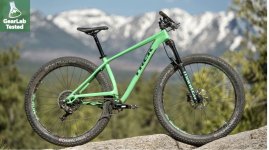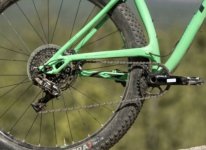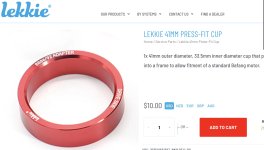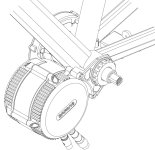Some speculation: Since the stay on the drive side is at a different location relative to the BB shell vs the non drive side, there will be some twisting of the frame below the stay connection point to the seatpost above the BB shell, and some amount of chainline deformation from that. It will probably be so small that it won't matter...but if the applied torque is high enough and the loading is highly cyclic, it could stress the frame across that point and someday cause fatigue cracking.
Some other thoughts:
If you wanted to use an IGH on the rear wheel rather than derailer, you could adapt the system to a Gates belt drive (which normally requires a split frame). There are a few threads about that sort of thing if you want to see the details.
A chain could still be used instead of the belt, and still use an IGH, for some advantages either way.
The belt (or chain) / IGH will have less chance of chain derailment or damage during shifting due to accidental shifting under power, as long as the IGH is designed to do this internally (for instance, Rohloff has the gear detents inside it instead of in the shifter, so you don't get gear munching inside because of incomplete shifts, etc...but it's still better to cut power during the shifts).
There's less stress on the wheel's axle, and it's possible to reduce stress on the BB and axle, by moving the chainline as far inboard as possible without frame strike/rub, and keeping it there in a nice straight line.
The IGH would be less vulnerable to environmental damage than the derailer and cassette/freewheel mechanism.
Belts vs chains is a thing to look into for +/- for your specific use case, since each has limitations.
You could probably lower the gearing on the bigger wheels to make them "the same" as the smaller ones; AFAICS it's a pretty small difference.. For non-fat tires in the sub-2.5" range I think it would need to be about 94% (or 106%, depending on which way it goes) of the gearing you'd've used with the smaller one on same type of tires.
Regarding range, that depends on the power usage vs battery capacity. "Best" battery in that event includes capacity and not just well-matched cells (apparently almost impossible to get in an ebike battery unless you build one from used EV-grade cells) that are high quality, built correctly with good interconnects into a proper enclosure for your riding situation, with whatever BMS may be necessary to protect the cells in your usage.
At higher speeds and higher power levels, you'll have less range with the same capacity battery. At much higher power levels and speeds, battery capacity requirement for the same range increases dramatically, so for more range it gets bigger even faster. If you know the power requirements for your intended usage, you can guesstimate Wh/mile, and thus for a given range the Wh capacity of battery required. If you don't know the power needed, you can use the ebikes.ca motor simulator to make some guesstimates. (it will take some learning and experimentation to use the simulator for your usage and setup).







